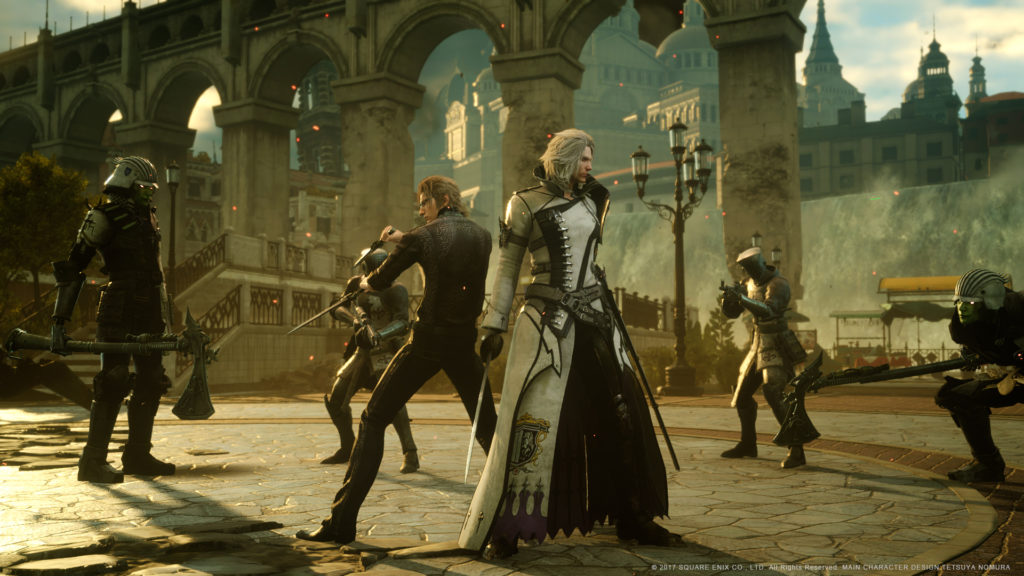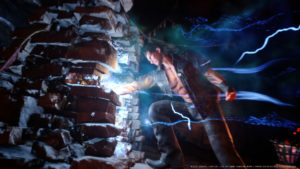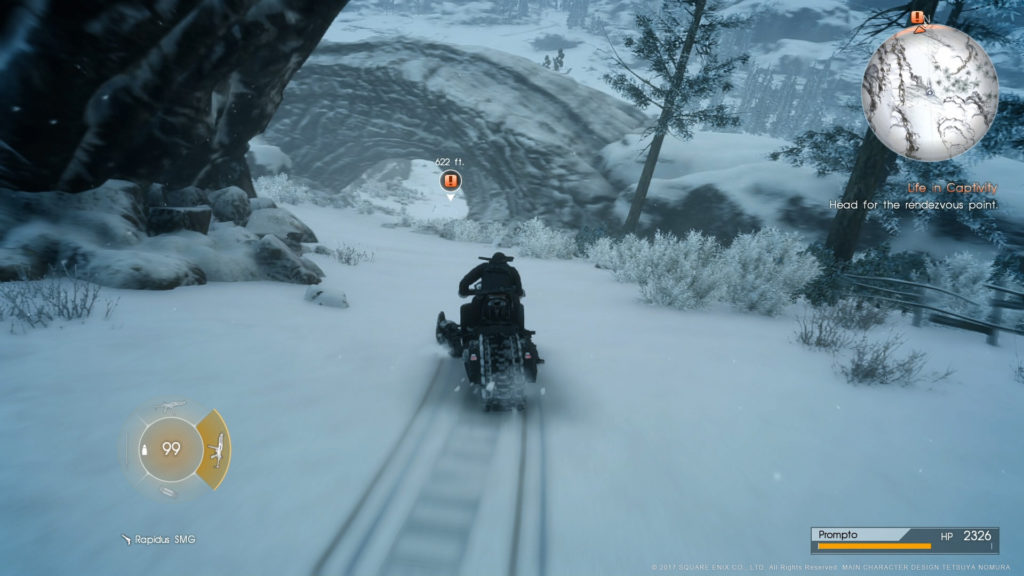Jack Menhorn: Tell us about yourself. What led you into doing sound design for games?
Atsushi Suganuma: I am Atsushi Suganuma, I am an audio director at Square-Enix Japan.
I worked on both “FINAL FANTASY XV” game development as well as the CG animation feature film “KINGS GLAIVE FINAL FANTASY XV”.
On the game side, I was managing our audio team as Audio Lead alongside with the other Audio Lead “Masayuki Sato” together for “FINAL FANTASY XV” 2016 released game.
On the film side, I was a sound supervisor for the KINGS GLAIVE FINAL FANTASY XV, supervising all aspect of the VO, Music and Sound effects throughout the whole film production.
My curiosity in game audio started when I was suggested in career in game audio by my mentor in England. At the time, a career in game audio stood out as really fresh and completely new career path as opposed to the one in traditional Film and TV or music industry.
JM: For you what is the most important process in the creation of sound for video games?
AS: For me, the most important process would be when we start building custom sound system to create a unique roadmap of the overall audio for each game. Usually, this process begins with collecting all of the game design concepts from the game director. With all the essential concepts in mind, the process begins with laying out the roadmap for the each aspect of dialog, music, and sound effects.
During FINAL FANTASY XV game development, we managed to build several custom sound systems, such as, the custom motion automated sound system for each character`s animation sounds, environment driven ambient sound system, procedural vehicle sound system, interactive music system and in-game snapshot mixing system and so on.
 JM: I would assume making sound for any Final Fantasy project is a very large task, especially Final Fantasy XV, which is set in an open world. What was your experience like making sound on a project where the player could go anywhere and do whatever they wanted?
JM: I would assume making sound for any Final Fantasy project is a very large task, especially Final Fantasy XV, which is set in an open world. What was your experience like making sound on a project where the player could go anywhere and do whatever they wanted?
AS: It was certainly a huge challenge for all of us in the dev team to develop FINAL FANTASY XV in an open world. Our game design team worked greatly to build an open world settings that has individual ecosystems in each part of the world.
We worked closely with our game design team and was instructed with their specific guidelines for those ecosystems. It was really refreshing approach and gave us much more freedom to bring new ideas for both building new sound systems as well as creating new sound palettes.
Just to give you an example, the part “Leide” is set on dry arid climate where you see the monsters of hyena-like, bison-like creatures living around open field. Whereas the part “Claigne” is set on tropical wet climate that game players can find wetlands with tropical insects, crocodile-like creatures, and giant tropical birds-like creature living in the land.
Also it is worth to mention that ecosystem changes slightly throughout the day in 24hour cycle. As the day progresses, game players are expected to see more dangerous creatures after dusk who are much harder to combat. And the weather condition changes randomly throughout the day as well.
Our focus was on how sound design should emphasize those ecosystems and how we can let game players feel the changes in scenery when they travel to different parts of the world.
For the creature sound, we implemented big chunk of unique sound palettes for each individual creatures to be able to work well with each game state of their AI system. For the environmental sound, we built ambient sound system to work perfectly with both 24 hour progression and weather changes depending on the game state. The ambient sound system functions great on affecting surrounding environment in real-time. Peaceful birds chirp in the morning, eerie wind gust at night, sudden heavy rain and unexpected thunder and lightning are the example of what the ambient sound system controls depending on which game state currently is in.
JM: There were new features like “First Person Mode” added to the recent release of Final Fantasy XV Windows Edition. Are there any new sound features as well?
AS: For the development of FINAL FANTASY XV Windows Edition, the most challenging new feature that we worked on was WINDOWS SONIC (Dolby Atmos included) compatibility for the game.
It was challenging because we faced huge CPU constraints as well as memory limitations for the implementation. In order to achieve our goal, we decided to implement the channel based approach as opposed to object based instead.
To maximize the WINDOWS SONIC spatial audio experience for the game users, we managed to build custom DSP solution on spatial audio, using 7.1.4 channels compatible custom reverb for the game.
JM: Could you talk more about the environment driven ambient sound system and the procedural vehicle sound system? The Regalia is such a big part of Final Fantasy 15, I would love to hear more about what went into its sonic character.
AS: Our ambient sound system for FINAL FANTASY XV is actually very simple. .
If the player runs through the forest with lots of trees around you, then the sound system counts number of trees around the player to calculate how the dense the forest is.
Then the system lets our preparatory sound driver play the certain layers of ambient tree sounds in real-time within the player`s radius.
We applied the same our ambient sound system method to playing crowd voices when the player is in the town or city environment. The city “Lestllum” for example, when the player is at the market in Lestllum where the crowds of people are there wondering about, the ambient sound system pick out the density of crowds and it lets the sound driver play particular layers of walla sound depending of crowd density.
As you mentioned about the Regalia, you are totally right about the importance of Regalia in FINAL FANTASY XV. Our goal was to build procedural vehicle sound system especially for Regalia to sound as convincing as possible in the open world.
The system is built in very unique way and long hard working hours spent by our Advanced Technology Division. The system extracts the fundamental frequency from the recording and it creates numbers of unique loop sounds in order to synchronize with the exact RPM of Regalia when drives around on the road.
It was also real fun when we created Regalia Type-D, the buggy mode, with the use of the system for that particular game update. Regalia Type-D finally managed to drive literally everywhere in the open world from that game update. It was then the potential of vehicle sound system were discovered and for us the hard work was really paid off.
JM: Please elaborate more about your channel based approach, rather than object based for optimization.
AS: Let me explain further as to why we chose channel based approach for the Windows Edition development.
The main reason was that the channel based approach was the best way to preserve the existing system on our preparatory sound driver and build the extension from the existing 7.1 setup onto the 7.1.4 spatial audio. Our 7.1.4 channel supported DSP that we built especially for the Windows Edition worked tremendously well with this extension method as DSP feeds the input from the existing 7.1 surround reverb to feed back to create Height channel with carefully adding delay on top of it.
We had our target for CPU and Memory usage for the release and our 7.1.4 supported DSP worked very well and was within the target range for the Windows Edition.
The other reason was the multi-platform solution.
We needed to target Xbox One console integration along with Windows Edition.
Because we chose the extension method, our optimization succeeded well on the console as well and managed to integrate 7.1.4 spatial audio on Xbox One as well as Xbox One X console.
Also the other reason was the object panning.
Our preparatory sound driver diverges each sound field very specifically using its own divergence function. So that positioning of each sound would have to be accurate. And if we were to choose object based approach, our sound driver would not be able to signal out and function properly onto Atmos side.
JM: Thank you so much for taking part in this interview with me. Is there anything else you would like to mention or say to our readers?
AS: Absolutely! I am really honored to be interviewed on “Desigingsound.org”.
I think Desigingsound.org has long been a fantastic place to learn great insight with the diversity from all the best audio professionals in film, TV and games for the audio community internationally.
I hope my contribution from Tokyo would be somewhat beneficial for your readers in any way.



Thank you for this interesting interview.
Thank you as well !